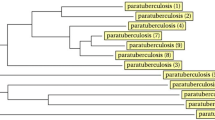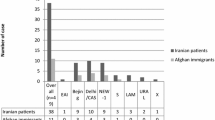Abstract
In recent years in spite of medical advancement, tuberculosis remains as a worldwide health problem. Therefore, identifying the source of transmission of infection is necessary for decreasing of tuberculosis (TB), also determining the varieties of TB strains by DNA fingerprinting helps to achieve this objective. The aim of present study was to determine tuberculosis transmission dynamics in Northwest of Iran with MIRU-VNTR and IS6110-RFLP methods. MIRU-VNTR performed for analysis of 125 strains and restriction fragment length polymorphism (RFLP) typing was performed on 119 culture-positive specimens during a period of September 2002 to March 2003 in tuberculosis centres of the region. We found 93 distinct MIRU-VNTR patterns, including in 21 clustered patterns and 72 unique patterns from isolated strains. The discriminatory power of MIRU-VNTR typing in our study was high (Hunter-Gaston discriminatory index, HGDI=0.9932) for isolates. Ninety-three distinct IS6110 patterns were revealed. Twelve clusters were found among total of 38 strains. The clusters included 26 patients who infected by 12 another’s. HGDI for our IS6110-RFLP method was 0.9928. The minimum estimate for the proportion of tuberculosis that was due to transmission with IS6110-RFLP was 21.9% and with MIRU-VNTR was 26.4%. In clusters the same patterns of Nakhichevanees patients and Iranian patients were revealed in three clusters with MIRU-VNTR and one cluster in IS6110 which showed that Nakhichevanees patients referred to tuberculosis centres of province could be a source of tuberculosis transmission. RFLP typing has more discriminatory power and it can be concluded that this method is a useful instrument for the better understanding of transmission and the occurrence of micro-epidemics and source tracing.
Similar content being viewed by others
References
Alland D., Kakut G.E., Moss A.R., McAdam R.A., Hahn J.A., Bosworth W., Druker E., Bloom B.R. (1994). Transmission of tuberculosis in New York City. Analysis by DNA fingerprinting and conventional epidemiology methods. N. Engl. J. Med., 330: 1710–1716.
Allix C., Supply P., Fauville-Dufaux M. (2004). Utility of fast mycobacterial interspersed repetitive unit-variable number tandem repeat genotyping in clinical mycobacteriological analysis. Clin. Infect. Dis., 39: 783–789.
Barnes P.F., Cave M.D. (2003). Current concepts molecular epidemiology of tuberculosis. N. Engl. J. Med., 349: 1149–1156.
Blackwood K.S., Wolfe J.N., Kabani A.M. (2004). Application of mycobacterial interspersed repetitive unit typing toMycobacterium tuberculosis cases; can restriction fragment length polymorphism be forgotten. J. Clin. Microbiol., 42: 5001–5006.
Bock N.N., Mallory J.P., Mobley N., Devoe B., Taylor B.B. (1998). Outbreak of tuberculosis associated with a floating card game in the rural south: lessons for tuberculosis contact investigation. Clin. Infect. Dis., 27: 1221–1226.
Borgdorff M.W., Behr M.A., Nogelkerke N.J.D., Hopewell P.G., Small P.M. (2000). Transmission of tuberculosis in San Francisco association with immigration and ethnicity. Int. J. Tuberc. Lung Dis., 4: 287–294.
Braden C.R., Templeton G.L., Cave M.D., Valwey S., Onorato M., Castro K.G., Moers D., Yang Z., Stead W.W., Bates J.H. (1997). Interpretation of restriction fragment length polymorphism analysis ofMycobacterium tuberculosis isolates from a state with a large rural population. J. Infect. Dis., 175: 1446–1452.
Cowan L.S., Mosher L., Diem L., Massey J.P., Crawford J.T. (2002). Variable number tandem repeat typing ofMycobacterium tuberculosis isolates with low copy number of IS6110 by using mycobacterial interspersed repetitive units. J. Clin. Microbiol., 40: 1592–1602.
Diel R., Schneider S., Meywald-walter C., Ruf C.M., Rusch-Gerdes S., Niemann S. (2002). Epidemiology of tuberculosis in Hamburg, Germany: long-term population-based analysis applying calssical and molecular epidemiological techniques. J. Clin. Microbiol., 40: 532–539.
Dye C., Scheele S., Dolin P., Pathania V., Raviglione M.C. (1999). Consensus statement: global burden of tuberculosis: estimated incidence, prevalence, and mortality by country. JAMA, 282: 677–686.
Farnia P., Mohammadi F., Fadda G. (2001). Transmission pattern of tuberculosis using RFLP based IS6110. Arch. Irn. Med., 4: 177–182.
Godfrey-Fausset P., Sonnenberg P., Shearer S., Bruce M., Mee C., Morris L., Murray J. (2000). Tuberculosis control and molecular epidemiology in a South Africa gold mining community. Lancet, 356: 1066–1077.
Hunter P.R., Gaston M.A. (2003). Numerical index of the discriminatory ability of typing system: an application of Simpsons index of diversity. J. Clin. Microbiol., 26: 2465–2466.
Magdalena J., Vachée A., Supply P., Locht C. (1998). Identification of a new DNA region specific for members ofMycobacterium complex. J. Clin. Microbiol., 36: 937–943.
Maguire H., Dale J.W., McHugh T.D., Botcher P.D., Gillespie S.H., Costetsos A., Al-ghusein H., Holland R., Dickens A., Marston L., Wilson P., Pitman R., Strachan D., Drobniewski F.A., Banerjee D.K. (2002). Molecular epidemiology of tuberculosis in London 1995–1997 showing low rate of active transmission. Thorax, 57: 617–622.
Mazars E., Lesjean S., Banuls A.L., Gilbert M., Vincent V., Gicquel B., Tibayrenc M., Locht C., Supply P. (2001). High resolution minisatellite based typing as a portable approach to global analysis ofMycobacterium tuberculosis molecular epidemiology. Proc. Nat. Acad. Sci. USA, 98: 1901–1906.
Oelemann M.C., Diel R., Vatin V., Haas W., Rusch-Gerdes S., Locht C., Niemann S., Supply P. (2007). Assessment of an optimized myobacterial interspersed repetitive unit-variable number tandem repeat typing system combined with Spoligotyping for population based molecular epidemiology studies of tuberculosis. J. Clin. Microbiol., 45: 691–697.
Pfyffer G.E., Strassele A., van Gorkom T. (2001). Multidrug resistant tuberculosis on prison inmate Azerbaijan. Emerg. Infect. Dis., 7: 885–886.
Rieder H.L., Chonde T.M., Myking H. (2000). The public health service national tuberculosis reference laboratory and the national laboratory network, IUATLD, 60–74. www.TBrieder.com
Scott A.N., Menzies D., Tannenbaum T.N., Thibert L., Kozak R., Joseph L., Schwartzman K., Behr M.A. (2005). Sensitivies and specifities of Spoligotyping and mycobacteial interspersed repetitive unit-variable-number tandem repeat typing methods for studying molecular epidemiology study of tuberculosis. J. Clin. Microbiol., 43: 89–94
Small P.M., Hopewell P.C., Singh S.P., Paz A., Parsonnet J., Ruston D.C., Schectter G.F., Daley C.L., Schoolink G.K. (1994). The epidemiology of tuberculosis in San Francisco. A population based study using conventional and molecular methods. N. Engl. J. Med., 330: 1703–1709.
Sun Y.J., Bellamy R., Lee A.S., Ng S.T., Ravindran S., Wong S.Y., Locht C., Supply P., Paton N.I. (2004). Use of mycobacterial interspersed repetitive unit-variable number tandem repeat typing to examine genetic diversity ofMycobacterium tuberculosis in Singapore. J. Clin. Microbiol., 42: 1986–1993.
Supply P., Mazars E., Lesjean S., Gicquel B., Locht C. (2001a). Variable human minisatellite like region in theMycobacterium tuberculosis genome. Mol. Microbiol., 36: 762–771.
Supply P., Lesjean S., Savine E., Kremer K., van Soolingen D., Locht C. (2001b). Automated high throughout genotyping for study of global epidemiology ofMycobacterium tuberculosis based on mycobacterial interspersed repetitive units. J. Clin. Microbiol., 39: 3563–3571.
Supply P., Allix C., Lesjean S., Cardoso-Oelemann M., Rusch-Gerdes S., Willery E., Savine E., de Haas P., van Deutekom H., Roring S., Bifani P., Kurepina N., Kreiswirth B., Sola C., Rastogi N., Vatin V., Gutierrez M.C., Fauville M., Niemann S., Skuce R., Kremer K., Locht C., van Soolingen D. (2006). Proposal for standardization of optimized mycobacterial interspersed repetitive unit-variable number tandem repeat typing ofMycobacterium tuberculosis. J. Clin. Microbiol., 44: 4498–4510.
Valway S.E., Sanchez M.P.C., Schinnick T.F., Orme I., Agerton T., Hoy D., Jones J.S., Westmoreland H., Onorato I.M. (1998). An outbreak involving extensive transmission of a virulent strain ofMycobacterium tuberculosis. N. Engl. J. Med., 338: 633–639.
van Deutekom H., Supply P., de Hass P.E.W., Willery E., Hoijng S.P., Locht C., Coutinho R.A., van Soolingen D. (2005). Molecular typing ofMycobacterium tuberculosis by mycobacterial interspersed repetitive unit-variable number tandem repeat analysis, a more accurate method for identifying epidemiological links between patients with tuberculosis. J. Clin. Microbiol., 43: 4473–4479.
van Embden J.D., Cave M.D., Crawford J.T., Dale J.W., Eisenach K.D., Gicquel B., Hermans P., Martin C., Mcadam R., Shinnick T.M. (1993). Strain identification ofMycobacterium tuberculosis by DNA fingerprinting: recommendations for a standardized method. J. Clin. Microbiol., 31: 406–409.
van Soolingen D., de Hass P.E.W., Harmans P.E.W., van Embden J.D.A. (1994). DNA fingerprinting ofMycobacterium tuberculosis. Methods Enzymol., 232: 196–205.
van Soolingen D., Borgdorff M.W., de Hass P.E. (1999). Molecular epidemiology of tuberculosis in the Netherlands, a nationwide study from 1993 through 1997. J. Infect. Dis., 180: 726–736.
van Soolingen D. (2001). Molecular epidemiology of tuberculosis and other mycobacterial infections: main methodologies and achievements. J. Intern. Med., 249: 1–26.
WHO (2006). Global Tuberculosis Control: Surveillance, Planning, Financing. WHO Report, Geneva, WHO/HTM/TB/2006.362.
Author information
Authors and Affiliations
Corresponding author
Rights and permissions
About this article
Cite this article
Asgharzadeh, M., Kafil, H.S. & Khakpour, M. Comparison of mycobacterial interspersed repetitive unit-variable number tandem repeat and IS6110-RFLP methods in identifying epidemiological links in patients with tuberculosis in Northwest of Iran. Ann. Microbiol. 58, 333–339 (2008). https://doi.org/10.1007/BF03175339
Received:
Accepted:
Issue Date:
DOI: https://doi.org/10.1007/BF03175339




